Effects of Plastic Waste on the Heat-Induced Spalling Performance and Mechanical Properties of High Strength Concrete
Abstract
1. Introduction
2. Experimental Program
2.1. Plastic Waste: Preparation, Identification, and Characterization
2.2. Production of High-Strength Concrete
2.3. Heating–Cooling Procedure
2.4. Assessment of Concrete Behavior at High Temperature
3. Results and Discussion
3.1. Identification and Characterization of Plastic Waste
3.2. Heat-Induced Concrete Spalling
3.3. Mechanical Properties
4. Conclusions
- Plastic waste dispersed in concrete helped mitigate heat-induced concrete spalling by releasing internal pressure after polymer melting.
- The vapor pressure dissipation network caused by PP fibers are mainly related to the formation of continuous channels, while plastic waste caused discontinuous reservoirs that lead to less damage in the concrete matrix.
- The residual mechanical performance of concrete with 3 kg/m3 of plastic waste is comparable to the reference concrete, with the advantage of heat-induced concrete spalling mitigation.
- The incorporation of 6 kg/m3 not only improved the heat-induced concrete spalling, but also the mechanical performance after exposure to high temperature.
Supplementary Materials
Author Contributions
Funding
Acknowledgments
Conflicts of Interest
References
- Camilo, J.R.; Rohden, A.B.; Garcez, M.R. Concrete with rejected recyclable plastic waste at high temperatures. Mag. Concr. Res. 2020, 1–15. [Google Scholar] [CrossRef]
- Li, X.; Ling, T.C.; Hung Mo, K. Functions and impacts of plastic/rubber wastes as eco-friendly aggregate in concrete—A review. Constr. Build. Mater. 2020, 240, 1–13. [Google Scholar] [CrossRef]
- John, H. Circular Claims Fall Flat: Comprehensive USA Survey of Plastics Recyclability; Greenpeace: Washington, DC, USA, 2020. [Google Scholar]
- Jambeck, J.; Geyer, R.; Wilcox, C.; Siegler, T.R.; Perryman, M.; Andrady, A.; Narayan, R.; Law, K.L. Plastic waste inputs from land into the ocean. Science (80-) 2015, 347, 3–6. [Google Scholar] [CrossRef] [PubMed]
- Faraj, R.H.; Hama Ali, H.F.; Sherwani, A.F.H.; Hassan, B.R.; Karim, H. Use of recycled plastic in self-compacting concrete: A comprehensive review on fresh and mechanical properties. J. Build. Eng. 2020, 30, 101283. [Google Scholar] [CrossRef]
- Geyer, R.; Jambeck, J.R.; Law, K.L. Production, use, and fate of all plastics ever made. Sci. Adv. 2017, 3, 25–29. [Google Scholar] [CrossRef] [PubMed]
- Silva, S.P. A Organização Coletiva de Catadores de Material Reciclável no Brasil: Dilemas e Potencialidades sob a ótica da Economia Solidária; IPEA: Rio de Janeiro, Brazil, 2017. [Google Scholar]
- CEMPRE. The Entrepreneurial Compromise for Recycling; CEMPRE: São Paulo, Brazil, 2016. [Google Scholar]
- Marzouk, O.Y.; Dheilly, R.M.; Queneudec, M. Valorization of post-consumer waste plastic in cementitious concrete composites. Waste Manag. 2007, 27, 310–318. [Google Scholar] [CrossRef]
- Garcez, M.R.; Rohden, A.B.; Godoy, L.G.G. de The role of concrete compressive strength on the service life and life cycle of a RC structure: Case study. J. Clean. Prod. 2018, 172, 27–38. [Google Scholar] [CrossRef]
- Rohden, A.B.; Garcez, M.R. Increasing the sustainability potential of a reinforced concrete building through design strategies: Case study. Case Stud. Constr. Mater. 2018, 9, 1–9. [Google Scholar] [CrossRef]
- Merli, R.; Preziosi, M.; Acampora, A.; Lucchetti, M.C.; Petrucci, E. Recycled fibers in reinforced concrete: A systematic literature review. J. Clean. Prod. 2020, 248, 119207. [Google Scholar] [CrossRef]
- Bhogayata, A.C.; Arora, N.K. Workability, strength, and durability of concrete containing recycled plastic fibers and styrene-butadiene rubber latex. Constr. Build. Mater. 2018, 180, 382–395. [Google Scholar] [CrossRef]
- Jacob-Vaillancourt, C.; Sorelli, L. Characterization of concrete composites with recycled plastic aggregates from postconsumer material streams. Constr. Build. Mater. 2018, 182, 561–572. [Google Scholar] [CrossRef]
- Almeshal, I.; Tayeh, B.A.; Alyousef, R.; Alabduljabbar, H. Eco-friendly concrete containing recycled plastic as partial replacement for sand. Integr. Med. Res. 2020. [Google Scholar] [CrossRef]
- Fournier, J.; Lacarrière, B.; Corre, O.; Le Hameed, M.; Ahmed, B.A. Employment the plastic waste to produce the light weight concrete. Energy Procedia 2019, 157, 30–38. [Google Scholar] [CrossRef]
- Górak, P.; Postawa, P.; Trusilewicz, L.N. Lightweight composite aggregates as a dual end-of-waste product from PET and anthropogenic materials. J. Clean. Prod. 2020, 256. [Google Scholar] [CrossRef]
- Yang, S.; Yue, X.; Liu, X.; Tong, Y. Properties of self-compacting lightweight concrete containing recycled plastic particles. Constr. Build. Mater. 2015, 84, 444–453. [Google Scholar] [CrossRef]
- Hama, S.M.; Hilal, N.N. Fresh properties of self-compacting concrete with plastic waste as partial replacement of sand. Int. J. Sustain. Built Environ. 2017, 6, 299–308. [Google Scholar] [CrossRef]
- Al-Hadithi, A.I.; Noaman, A.T.; Mosleh, W.K. Mechanical properties and impact behavior of PET fiber reinforced self-compacting concrete (SCC). Compos. Struct. 2019, 224. [Google Scholar] [CrossRef]
- Rahmani, E.; Dehestani, M.; Beygi, M.H.A.; Allahyari, H.; Nikbin, I.M. On the mechanical properties of concrete containing waste PET particles. Constr. Build. Mater. 2013, 47, 1302–1308. [Google Scholar] [CrossRef]
- Bui, N.K.; Satomi, T.; Takahashi, H. Recycling woven plastic sack waste and PET bottle waste as fiber in recycled aggregate concrete: An experimental study. Waste Manag. 2018, 78, 79–93. [Google Scholar] [CrossRef]
- Ferreira, L.; De Brito, J.; Saikia, N. Influence of curing conditions on the mechanical performance of concrete containing recycled plastic aggregate. Constr. Build. Mater. 2012, 36, 196–204. [Google Scholar] [CrossRef]
- Meng, Y.; Ling, T.C.; Mo, K.H. Recycling of wastes for value-added applications in concrete blocks: An overview. Resour. Conserv. Recycl. 2018, 138, 298–312. [Google Scholar] [CrossRef]
- Khalid, F.S.; Irwan, J.M.; Ibrahim, M.H.W.; Othman, N.; Shahidan, S. Performance of plastic wastes in fiber-reinforced concrete beams. Constr. Build. Mater. 2018, 183, 451–464. [Google Scholar] [CrossRef]
- Mohammadinia, A.; Wong, Y.C.; Arulrajah, A.; Horpibulsuk, S. Strength evaluation of utilizing recycled plastic waste and recycled crushed glass in concrete footpaths. Constr. Build. Mater. 2019, 197, 489–496. [Google Scholar] [CrossRef]
- Thorneycroft, J.; Orr, J.; Savoikar, P.; Ball, R.J. Performance of structural concrete with recycled plastic waste as a partial replacement for sand. Constr. Build. Mater. 2018, 161, 63–69. [Google Scholar] [CrossRef]
- Santhanam, N.; Anbuarasu, G. Experimental study on high strength concrete (M60) with reused E-waste plastics. Mater. Today Proc. 2019, 22, 919–925. [Google Scholar] [CrossRef]
- Mary Treasa Shinu, N.M.; Needhidasan, S. An experimental study of replacing conventional coarse aggregate with E-waste plastic for M40 grade concrete using river sand. Mater. Today Proc. 2019, 22, 633–638. [Google Scholar] [CrossRef]
- Phan, L.T. Pore pressure and explosive spalling in concrete. Mater. Struct. Constr. 2008, 41, 1623–1632. [Google Scholar] [CrossRef]
- Jansson, R. Fire Spalling of Concrete: Theoretical and Experimental Studies. Cem. Concr. Compos. 2013, 26, 155–162. [Google Scholar]
- Maluk, C.; Bisby, L.; Terrasi, G.P. Effects of polypropylene fibre type and dose on the propensity for heat-induced concrete spalling. Eng. Struct. 2017, 141, 584–595. [Google Scholar] [CrossRef]
- Kalifa, P.; Menneteau, F.D.; Quenard, D. Spalling and pore pressure in HPC at high temperatures. Cem. Concr. Res. 2000, 30, 1915–1927. [Google Scholar] [CrossRef]
- Yermak, N.; Pliya, P.; Beaucour, A.L.; Simon, A.; Noumowé, A. Influence of steel and/or polypropylene fibres on the behaviour of concrete at high temperature: Spalling, transfer and mechanical properties. Constr. Build. Mater. 2017, 132, 240–250. [Google Scholar] [CrossRef]
- Khoury, A.G. Polypropylene fibres in heated concrete. Part 2: Pressure relief mechanisms and modelling criteria. Mag. Concr. Res. 2008, 60, 189–204. [Google Scholar] [CrossRef]
- Maier, M.; Saxer, A.; Bergmeister, K.; Lackner, R. An experimental fire-spalling assessment procedure for concrete mixtures. Constr. Build. Mater. 2020, 232, 117172. [Google Scholar] [CrossRef]
- Li, X.; Bao, Y.; Wu, L.; Yan, Q.; Ma, H.; Chen, G.; Zhang, H. Thermal and mechanical properties of high-performance fiber- reinforced cementitious composites after exposure to high temperatures. Constr. Build. Mater. 2017, 157, 829–838. [Google Scholar] [CrossRef]
- Han, C.G.; Hwang, Y.S.; Yang, S.H.; Gowripalan, N. Performance of spalling resistance of high performance concrete with polypropylene fiber contents and lateral confinement. Cem. Concr. Res. 2005, 35, 1747–1753. [Google Scholar] [CrossRef]
- Ozawa, M.; Morimoto, H. Effects of various fibres on high-temperature spalling in high-performance concrete. Constr. Build. Mater. 2014, 71, 83–92. [Google Scholar] [CrossRef]
- Bilodeau, A.; Kodur, V.K.R.; Hoff, G.C. Optimization of the type and amount of polypropylene fibres for preventing the spalling of lightweight concrete subjected to hydrocarbon fire. Cem. Concr. Compos. 2004, 26, 163–174. [Google Scholar] [CrossRef]
- Fiore, V.; Scalici, T.; Di Bella, G.; Valenza, A. A review on basalt fibre and its composites. Compos. Part B Eng. 2015, 74, 74–94. [Google Scholar] [CrossRef]
- Khoury, G.A.; Willoughby, B. Polypropylene fibres in heated concrete. Part 1: Molecular structure and materials behaviour. Mag. Concr. Res. 2008, 60, 125–136. [Google Scholar] [CrossRef]
- Yu, K.; Yu, J.; Lu, Z.; Chen, Q. Fracture properties of high-strength/high-performance concrete (HSC/HPC) exposed to high temperature. Mater. Struct. Constr. 2016, 49, 4517–4532. [Google Scholar] [CrossRef]
- Yang, Z.; Ji, R.; Liu, L.; Wang, X.; Zhang, Z. Recycling of municipal solid waste incineration by-product for cement composites preparation. Constr. Build. Mater. 2018, 162, 794–801. [Google Scholar] [CrossRef]
- Lura, P.; Terrasi, G. Pietro Reduction of fire spalling in high-performance concrete by means of superabsorbent polymers and polypropylene fibers: Small scale fire tests of carbon fiber reinforced plastic-prestressed self-compacting concrete. Cem. Concr. Compos. 2014, 49, 36–42. [Google Scholar] [CrossRef]
- Serrano, R.; Cobo, A.; Prieto, M.I.; González, M.d.l.N. Analysis of fire resistance of concrete with polypropylene or steel fibers. Constr. Build. Mater. 2016, 122, 302–309. [Google Scholar] [CrossRef]
- Araya-Letelier, G.; Maturana, P.; Carrasco, M.; Antico, F.C.; Gómez, M.S. Mechanical-damage behavior of mortars reinforced with recycled polypropylene fibers. Sustainability 2019, 11, 2200. [Google Scholar] [CrossRef]
- Moura, J.M.B.M.; Gohr Pinheiro, I.; Carmo, J.L. Gravimetric composition of the rejects coming from the segregation process of the municipal recyclable wastes. Waste Manag. 2018, 74, 98–109. [Google Scholar] [CrossRef]
- Braun, D. Simple Methods for Identifi Cation of Plastics; Hanser: Munich, Germany, 2013; ISBN 9781569905265. [Google Scholar]
- ASTM. ASTM 3850-19 Standard Test Method for Rapid Thermal Degradation of Solid Electrical Insulating Materials By Thermogravimetric Method (TGA); ASTM: Pennsylvania, PA, USA, 2019. [Google Scholar]
- ASTM. ASTM 3418-15 Standard Test Method for Transition Temperatures and Enthalpies of Fusion and Crystallization of Polymers by Differential Scanning; ASTM: Pennsylvania, PA, USA, 2015. [Google Scholar]
- Aïtcin, P.-C. High Performance Concrete, 1st ed.; E & FN Spon: London, UK, 1998. [Google Scholar]
- ABNT. NBR 16697 Portland Cement-Requirements; ABNT: São Paulo, Brazil, 2018. [Google Scholar]
- ASTM International. ASTM C 150/C150M-15 Standard Specification for Portland Cement; ASTM: Pennsylvania, PA, USA, 2015. [Google Scholar]
- ABNT. NBR 5738 Concrete-Procedure for Molding and Curing Concrete Test Specimens; ABNT: São Paulo, Brazil, 2015. [Google Scholar]
- ABNT. NBR 9479 Mortar and Concrete-Moist Rooms and Water Tanks for Curing; ABNT: São Paulo, Brazil, 2006. [Google Scholar]
- Sanchayan, S.; Gowripalan, N.; Foster, S.J. Mechanical properties of fibre reinforced reactive powder concrete after exposure to high temperatures. In From From Materials to Structures: Advancement through Innovation-Proceedings 22nd Australasian Conference on the Mechanics of Structures and Materials ACMSM 2012, 11–14 December 2012, Sydney, Australia; Taylor & Francis Group: London, UK, 2013; pp. 1177–1181. [Google Scholar]
- Li, Q.; Yuan, G.; Shu, Q. Effects of heating/cooling on recovery of strength and carbonation resistance of fire-damaged concrete. Mag. Concr. Res. 2014, 66, 925–936. [Google Scholar] [CrossRef]
- Zhao, J.; Zheng, J.J.; Peng, G.F.; van Breugel, K. Numerical analysis of heating rate effect on spalling of high-performance concrete under high temperature conditions. Constr. Build. Mater. 2017, 152, 456–466. [Google Scholar] [CrossRef]
- Phan, L.T.; Lawson, J.R.; Davis, F.L. Effects of elevated temperature exposure on heating characteristics, spalling, and residual properties of high performance concrete. Mater. Struct. Constr. 2001, 34, 83–91. [Google Scholar] [CrossRef]
- Mohamedbhai, G.T.G. Effect of exposure time and rates of heating and cooling on residual strength of heated concrete. Mag. Concr. Res. 1986, 38, 151–158. [Google Scholar] [CrossRef]
- ABNT. NBR 9779 Mortar and Hardened Concrete—Determination of Water Absorption by Capillarity; ABNT: São Paulo, Brazil, 2012. [Google Scholar]
- ABNT. NBR 8522 Concrete—Determination of Static Modulus of Elasticity and Deformation by Compression; ABNT: São Paulo, Brazil, 2017. [Google Scholar]
- ABNT. NBR 5739 Concrete—Compression Test of Cylindrical Specimens; ABNT: São Paulo, Brazil, 2018. [Google Scholar]
- ABNT. NBR 7222 Concrete and Mortar—Determination of the Tension Strength by Diametrical Compression of Cylindrical Test Specimens; ABNT: São Paulo, Brazil, 2011. [Google Scholar]
- Xing, Z.; Beaucour, A.L.; Hebert, R.; Noumowe, A.; Ledesert, B. Aggregate’s influence on thermophysical concrete properties at elevated temperature. Constr. Build. Mater. 2015, 95, 18–28. [Google Scholar] [CrossRef]
- Luo, X.; Sun, W.; Chan, Y.N. Residual compressive strength and microstructure of high performance concrete after exposure to high temperature. Mater. Struct. Constr. 2000, 33, 294–298. [Google Scholar] [CrossRef]
- Correia, J.R.; Lima, J.S.; De Brito, J. Post-fire mechanical performance of concrete made with selected plastic waste aggregates. Cem. Concr. Compos. 2014, 53, 187–199. [Google Scholar] [CrossRef]
- Xiong, M.X.; Richard Liew, J.Y. Spalling behavior and residual resistance of fibre reinforced Ultra-High performance concrete after exposure to high temperatures. Mater. Constr. 2015, 65. [Google Scholar] [CrossRef]
- Ali, M.H.; Dinkha, Y.Z.; Haido, J.H. Mechanical properties and spalling at elevated temperature of high performance concrete made with reactive and waste inert powders. Eng. Sci. Technol. Int. J. 2017, 20, 536–541. [Google Scholar] [CrossRef]
- Selvaggio, S.; Carlson, C. Restraint in Fire Tests of Concrete Floors and Roofs. In Proceedings of the Symposium on Fire Test Methods—Restraint & Smoke; Committee E-5, Ed.; ASTM International: West Conshohocken, PA, USA, 1967; pp. 21–39. [Google Scholar]
- Chan, S.Y.N.; Peng, G.F.; Chan, J.K.W. Comparison between high strength concrete and normal strength concrete subjected to high temperature. Mater. Struct. Constr. 1996, 29, 616–619. [Google Scholar] [CrossRef]
- CEN. EN 1992-2-1-2 Eurocode 2: Design of Concrete Structures—Part 1–2: General Rules—Structural Fire Design; CEN: Brussels, Belgium, 2004. [Google Scholar]
- Tufail, M.; Shahzada, K.; Gencturk, B.; Wei, J. Effect of Elevated Temperature on Mechanical Properties of Limestone, Quartzite and Granite Concrete. Int. J. Concr. Struct. Mater. 2017, 11, 17–28. [Google Scholar] [CrossRef]
- Neville, A.M. Properties of Concrete, 5th ed.; Pearson Education: Harlow, England, 2011. [Google Scholar]
- Mehta, P.K.; Monteiro, P.J.M. Concrete Microstructure Properties and Materials, 4th ed.; McGraw-Hill Education: New York, NY, USA, 2013. [Google Scholar]
- Georgali, B.; Tsakiridis, P.E. Microstructure of fire-damaged concrete. A case study. Cem. Concr. Compos. 2005, 27, 255–259. [Google Scholar] [CrossRef]
- Cree, D.; Green, M.; Noumowé, A. Residual strength of concrete containing recycled materials after exposure to fire: A review. Constr. Build. Mater. 2013, 45, 208–223. [Google Scholar] [CrossRef]

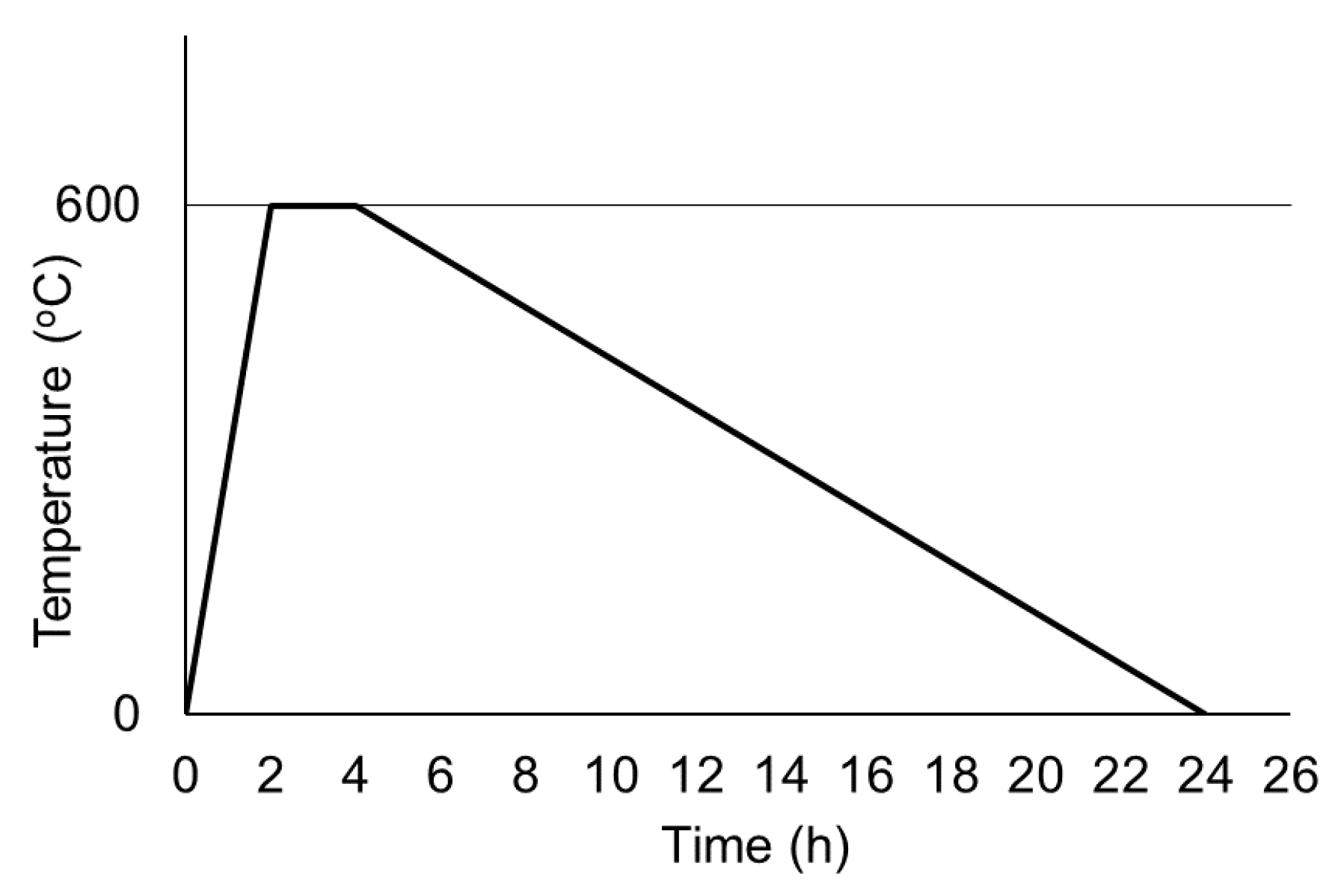
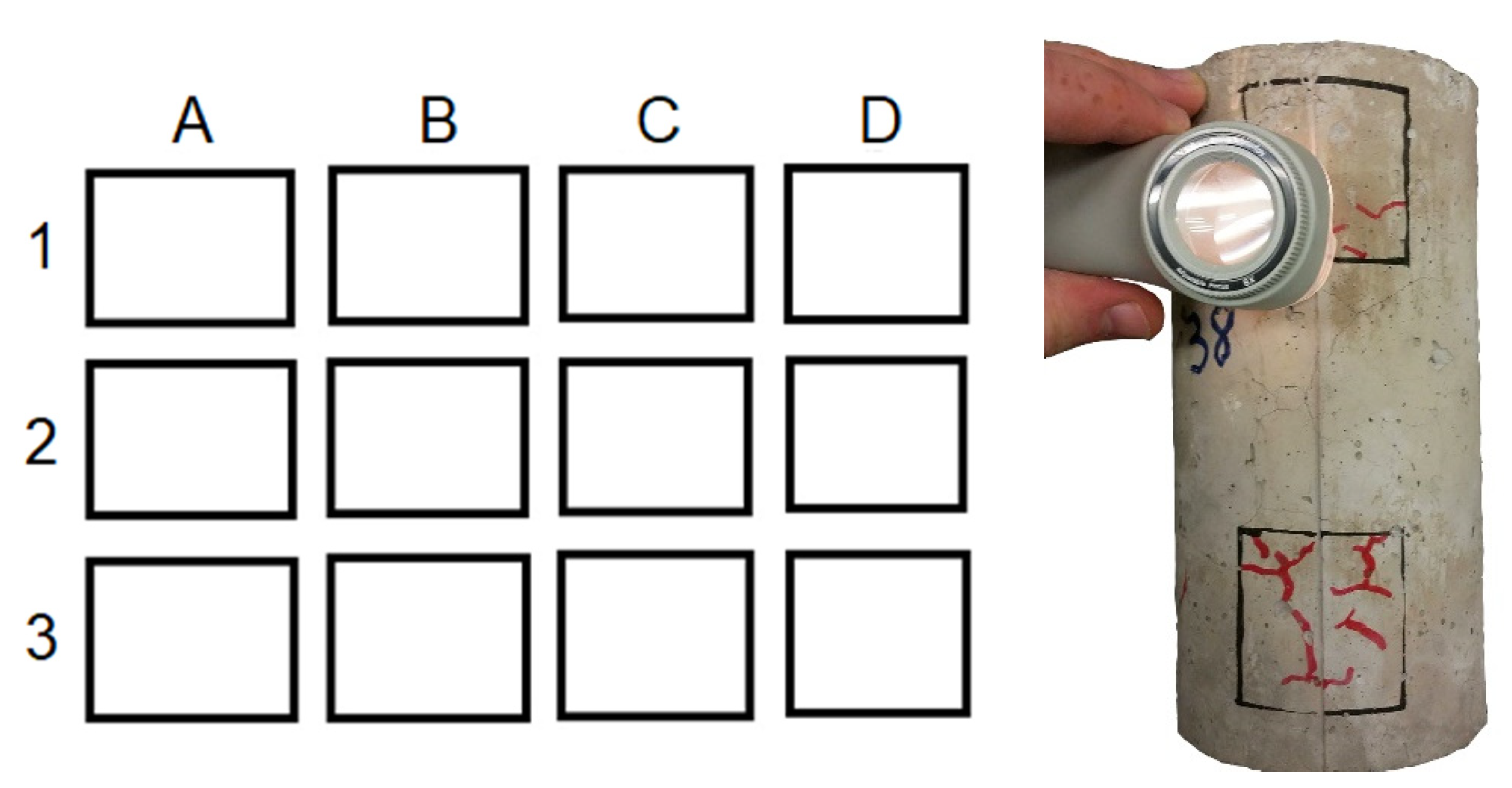
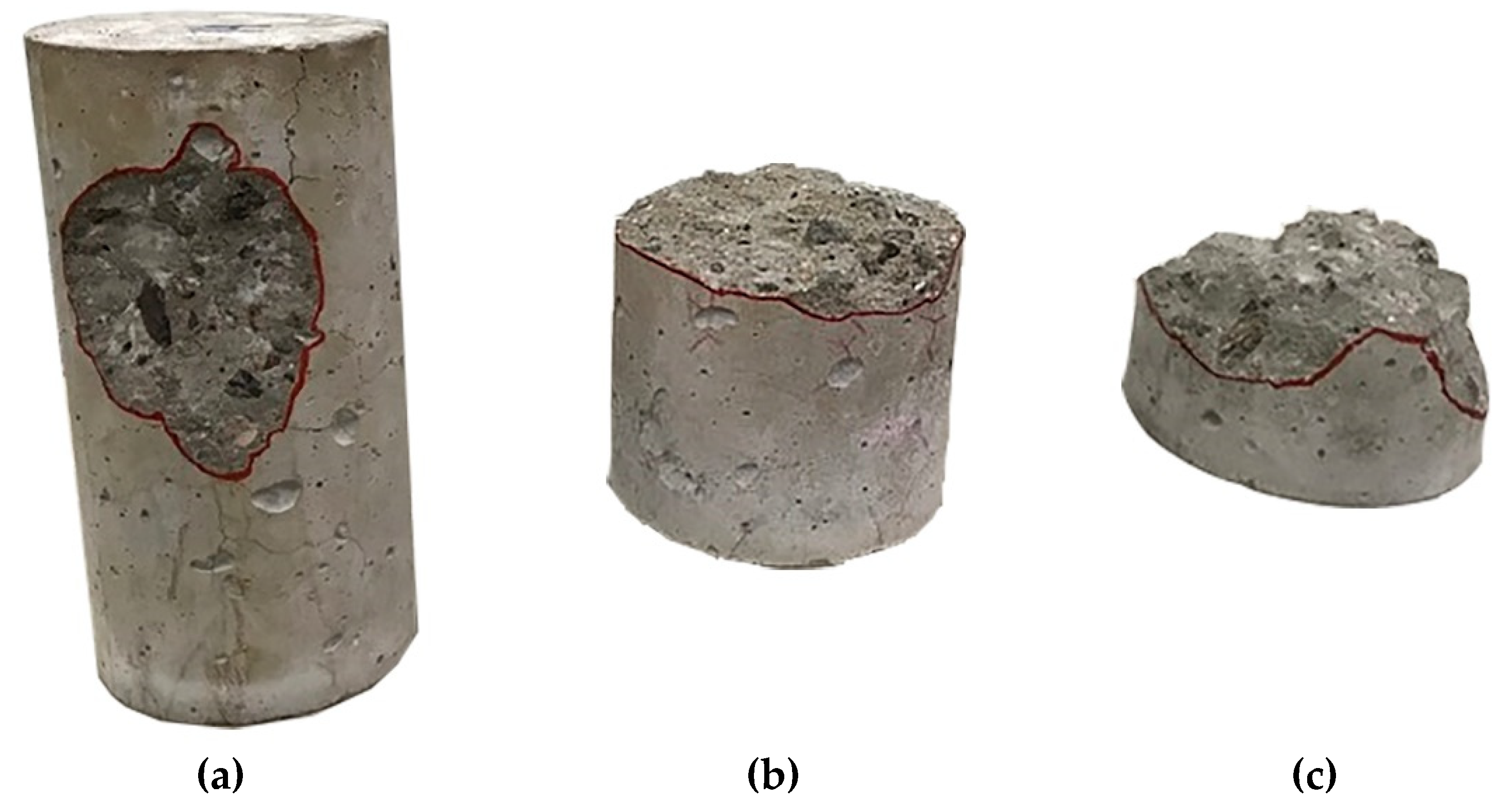
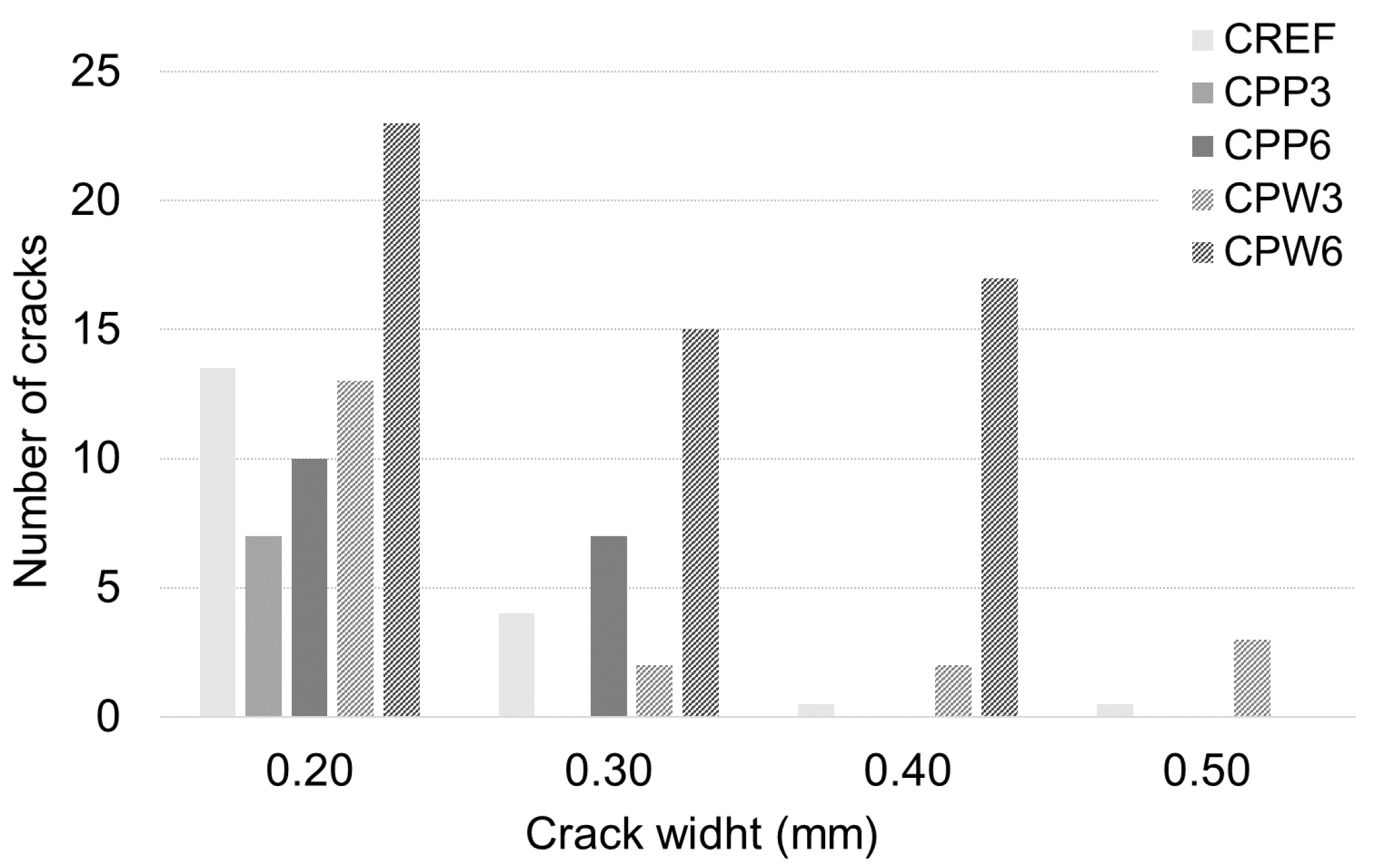
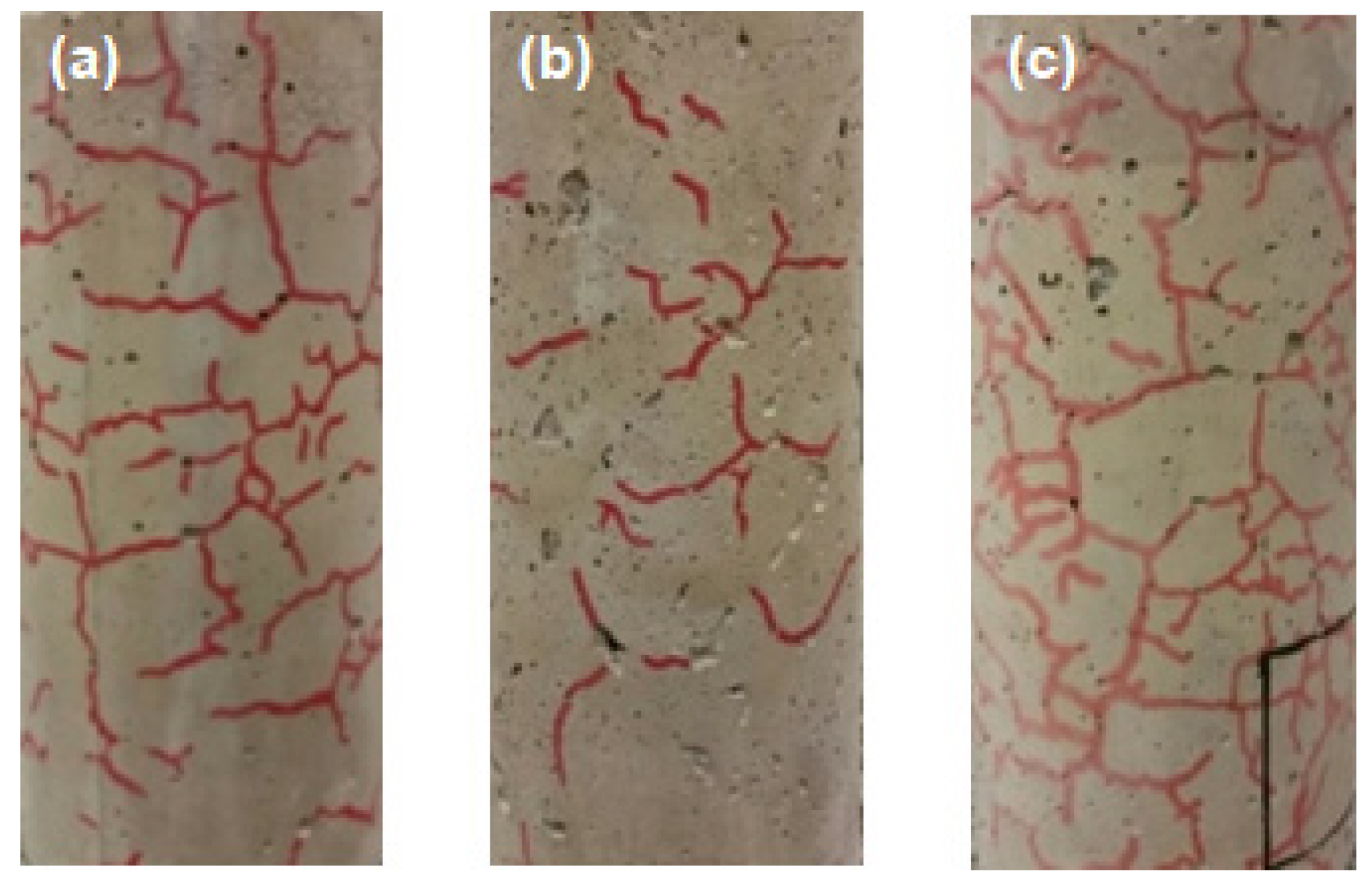
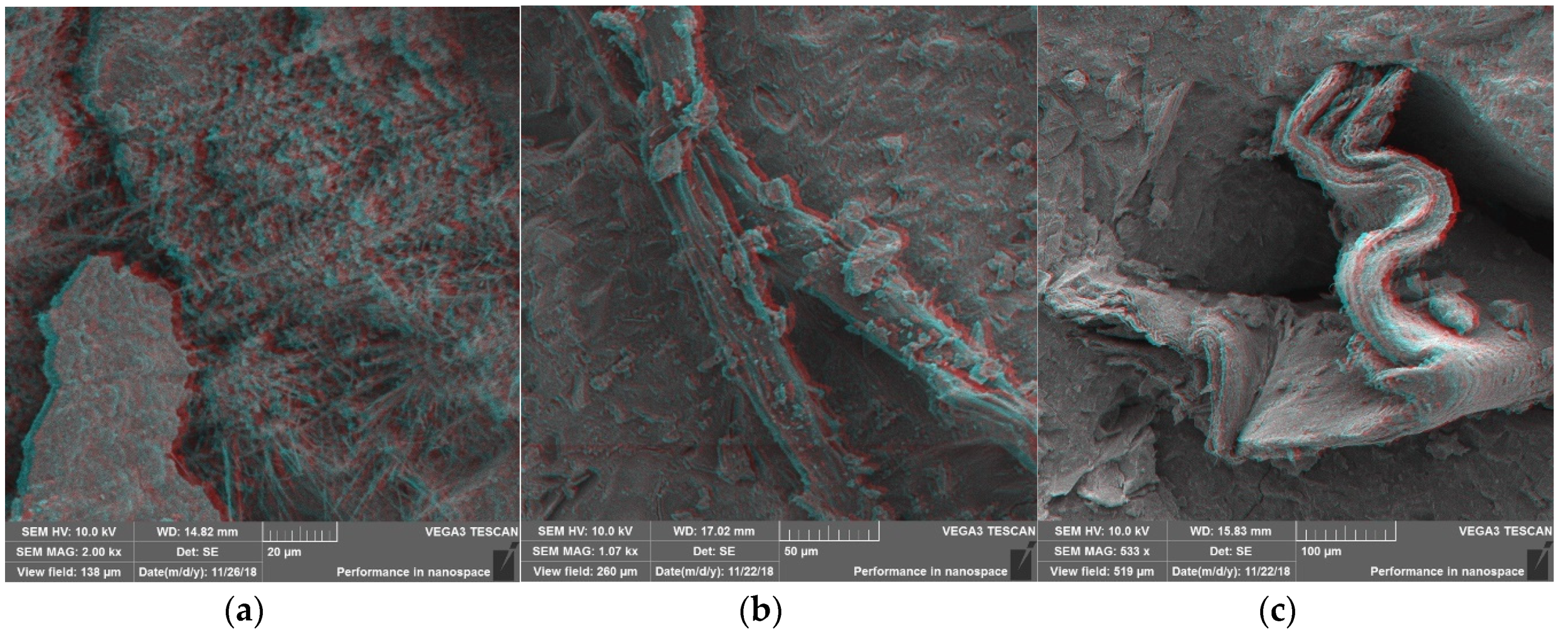


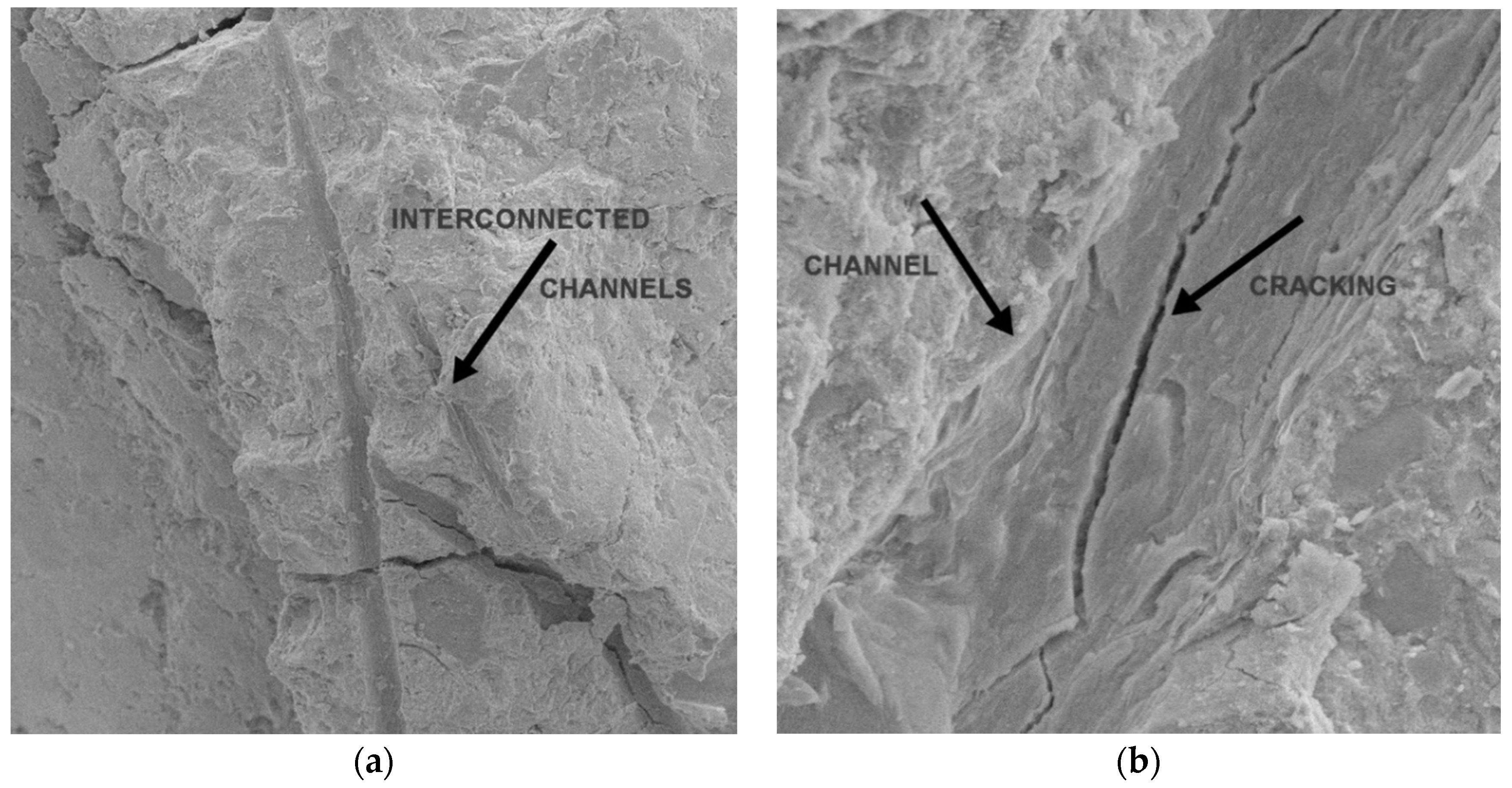
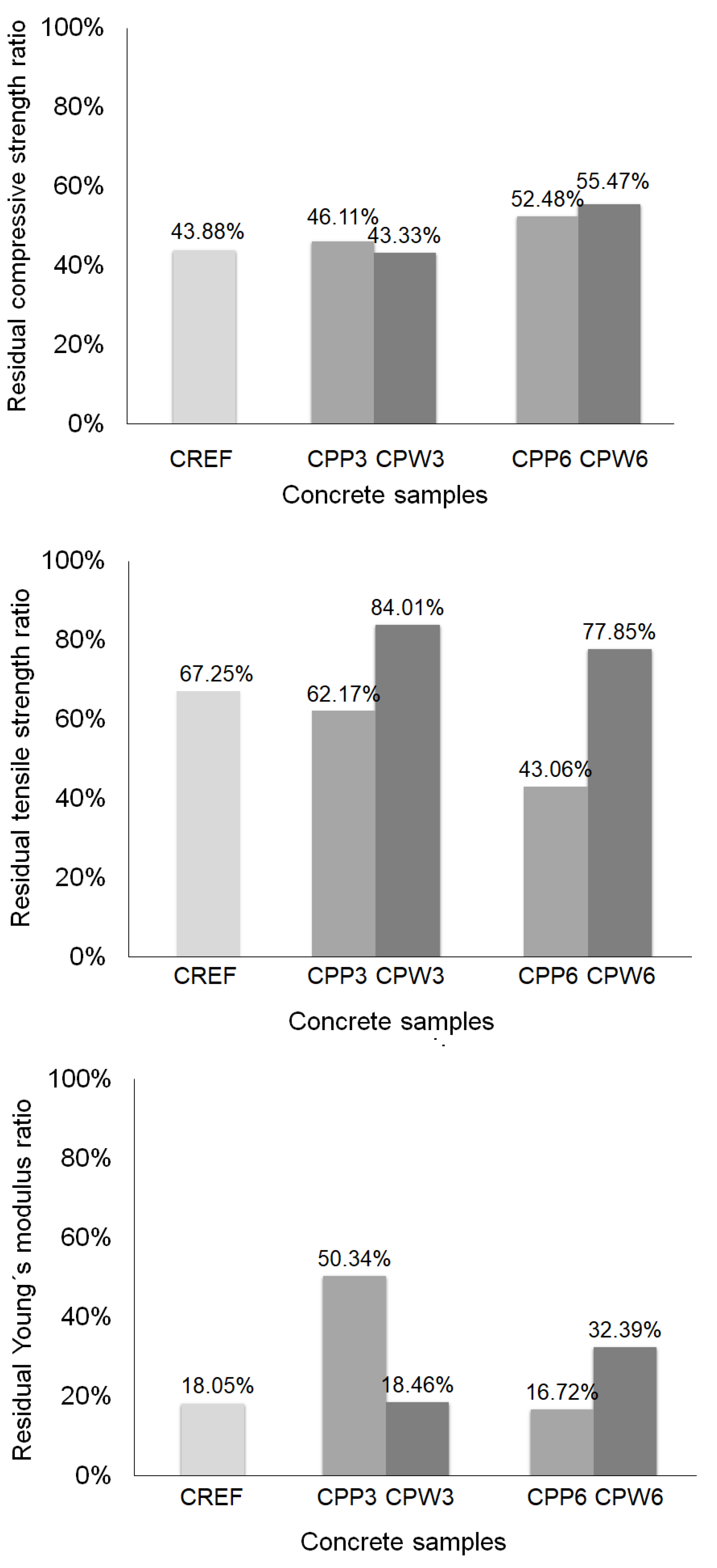
| Concrete * | Cement kg/m3 | RHA kg/m3 | Sand kg/m3 | Crushed Gravel kg/m3 | Water L/m3 | Admixture ** L/m3 | PP kg/m3 | PW kg/m3 |
|---|---|---|---|---|---|---|---|---|
| CREF | 450 | 50 | 708 | 1000 | 143 | up to 11 | - | - |
| CPP3 | 3 | - | ||||||
| CPP6 | 6 | - | ||||||
| CPW3 | - | 3 | ||||||
| CPW6 | - | 6 |
| Spalling Classification | Identification of Spalling Severity * |
|---|---|
| Level 1 Low Severity | Low popping sound. Detachment of small concrete fragments off the specimen surface with consequent formation of small grooves. |
| Level 2 Medium Severity | Medium popping sound. Detachment of concrete fragments off the specimen surface with consequent. formation large fragmented areas and damaged edges. |
| Level 3 High Severity | Sudden loud noise. Explosive rupture accompanied by failure of the concrete specimen. |
| Investigation | Number of Specimens per Concrete Mixture | Heating Condition (Temperature °C) | Specimen Geometry (mm) |
|---|---|---|---|
| Cracking Visual Inspection | 10 | 600 | Cylindrical ϕ 100 × 200 mm |
| Mass Loss | 20 | ||
| Water Absorption by Capillarity | 20 | Ambient-600 | |
| Compressive Strength | 13 | ||
| Tensile Strength | 3 | ||
| Young’s Modulus | 4 |
| Polymers | Concentration (%) |
|---|---|
| PC | 26.14 |
| HDPE | 21.12 |
| LDPE | 13.25 |
| PVC | 13.09 |
| PP | 11.35 |
| ABS | 11.21 |
| EPS | 2.64 |
| Other Plastics | 1.20 |
| Group | Source | Tm* (°C) | Thermal Degradation | ||
|---|---|---|---|---|---|
| Beginning (°C) | End (°C) | Mass Loss (%) | |||
| PP | Metalized Plastic | 130.22 | 362.30 | 462.17 | 93.27 |
| PVC, LDPE, HDPE, ABS | Hard Plastic, Pipes | 175.30 | 362.83 | 433.54 | 99.27 |
| 174.03 | 397.45 | 457.90 | 93.12 | ||
| PP, HDPE | Plastic Bag | 174.07 | 333.27 | 415.76 | 96.85 |
| 176.90 | 354.56 | 410.02 | 93.30 | ||
| PP | Wire | 167.41 | 359.64 | 460.78 | 99.52 |
| 174.76 | 403.06 | 462.39 | 98.83 | ||
| HDPE | Black Garbage Bag | 130.88 | 430.49 | 483.07 | 95.45 |
| Ration Bag | 130.50 | 430.92 | 486.59 | 94.44 | |
| PVC | Plastic Pool | 167.13 | 258.62 | 331.54 | 73.78 |
| PC, PVC | Clear Transparent Plastic | 261.96 | 413.15 | 461.95 | 99.88 |
| 260.37 | 404.84 | 471.76 | 99.79 | ||
| Concrete | Heat-Induced Spalling * | Cracking Level on the Concrete Surface ** | Mass Loss (%) *** | ||
|---|---|---|---|---|---|
| Low | Medium | High | |||
| CREF | - | ✔ | ✔ | +++ | 6.43 a |
| CPP3 | - | - | - | + | 5.91 b |
| CPP6 | - | - | - | ++ | 5.43 c |
| CPW3 | - | - | - | +++ | 6.51 a |
| CPW6 | - | - | - | +++++ | 5.79 b,c |
| Concrete | Absorption by Capillarity * (g/cm2) | |
|---|---|---|
| Before Heating | After Heating | |
| CREF | 0.14 a | 2.26 a |
| CPP3 | 0.12 a | 3.37 c |
| CPP6 | 0.06 a | 2.89 d |
| CPW3 | 0.10 a | 1.89 a,b |
| CPW6 | 0.07 a | 1.58 b |
| Concrete | Compressive Strength fcj (MPa) | Residual Compressive Strength frcj (MPa) | Tensile Strength ftj (MPa) | Residual Tensile Strength frtj (MPa) | Young’s Modulus E (MPa) | Residual Young’s Modulus Er (MPa) |
|---|---|---|---|---|---|---|
| CREF | 85.94 a | 37.71 a | 3.06 a | 2.06 a | 47.09 a,d | 8.50 a |
| CPP3 | 61.05 d | 28.15 c | 3.52 a | 2.19 a | 37.38 c | 19.12 c |
| CPP6 | 92.29 b | 48.43 d | 6.15 b | 2.65 a | 50.72 d | 8.48 a |
| CPW3 | 77.17 c | 33.44 a | 3.01 a | 2.53 a | 45.57 a | 8.41 a |
| CPW6 | 79.21 c | 43.94 b,d | 3.96 c | 3.08 b | 41.77 b | 13.53 b |
© 2020 by the authors. Licensee MDPI, Basel, Switzerland. This article is an open access article distributed under the terms and conditions of the Creative Commons Attribution (CC BY) license (http://creativecommons.org/licenses/by/4.0/).
Share and Cite
Rohden, A.B.; Camilo, J.R.; Amaral, R.C.; Garcez, E.O.; Garcez, M.R. Effects of Plastic Waste on the Heat-Induced Spalling Performance and Mechanical Properties of High Strength Concrete. Materials 2020, 13, 3262. https://doi.org/10.3390/ma13153262
Rohden AB, Camilo JR, Amaral RC, Garcez EO, Garcez MR. Effects of Plastic Waste on the Heat-Induced Spalling Performance and Mechanical Properties of High Strength Concrete. Materials. 2020; 13(15):3262. https://doi.org/10.3390/ma13153262
Chicago/Turabian StyleRohden, Abrahão Bernardo, Jessica Regina Camilo, Rafaela Cristina Amaral, Estela Oliari Garcez, and Mônica Regina Garcez. 2020. "Effects of Plastic Waste on the Heat-Induced Spalling Performance and Mechanical Properties of High Strength Concrete" Materials 13, no. 15: 3262. https://doi.org/10.3390/ma13153262
APA StyleRohden, A. B., Camilo, J. R., Amaral, R. C., Garcez, E. O., & Garcez, M. R. (2020). Effects of Plastic Waste on the Heat-Induced Spalling Performance and Mechanical Properties of High Strength Concrete. Materials, 13(15), 3262. https://doi.org/10.3390/ma13153262






